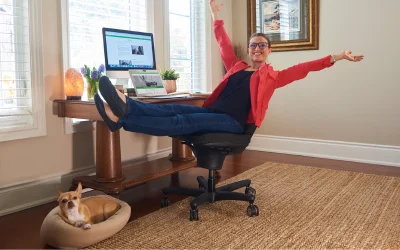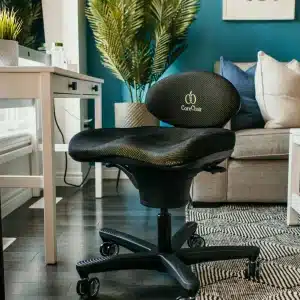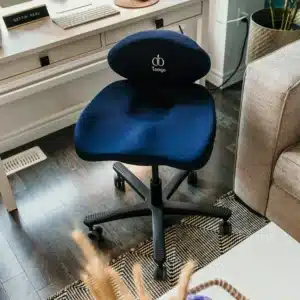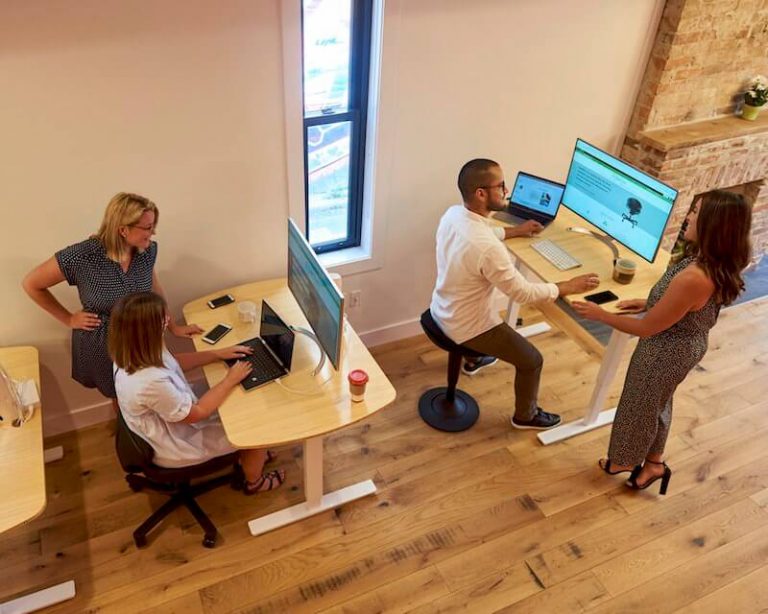Ergonomic Office Chairs: The Ultimate Guide to Finding the Perfect Fit
If your back hurts while sitting you definitely need to look for an ergonomic office for back pain relief that will suit your needs. This article will guide you towards choosing the right model for your specific needs. We will discuss different factors to consider including the desk height and angle, armrests, size of the seat and back, and even the material the chair is constructed from. With the varying degrees of adjustments available in most models, you can find an ergonomic chair that will suit your needs. If you are still searching for the perfect match, consider exploring this extensive list of ergonomic office chairs available now and become an informed consumer. While aesthetics are an important consideration, don’t compromise function with too much emphasis on form.
Why Does Your Back Hurt While Sitting?
Most of us can relate to that momentary feeling when we stand up after sitting static for a period of time when our back and hips feel like they have just been released from prison but can’t quite run away. For too many people this “my back hurts while sitting” discomfort carries on throughout their day. This is especially concerning for those who have no apparent history of back injury and find that the immediate discomfort diminishes as we completely straighten up and begin to take a few steps.
Researchers have been investigating this transient phenomenon for some time trying to figure out why everyone seems to suffer from back pain while sitting. They have theorized that when we assume positions that result in a significant imbalance of postural support muscles and ligaments and maintain static position for a long duration, there is an alarming amount of activity going on within the actual tissues. One key element is a reaction within these soft tissues that is referred to as “creep”.
Imagine the tissues surrounding a vertebral joint within your spine; when this joint assumes a flexed position (which is most likely to occur when you are sitting at a 90-degree hip flexion), your lumbar spine undergoes a flattened position.
This lumbar segment of your spine becomes flexed and the soft tissues on the front of your spine become shortened and those on the backside become lengthened. When we walk or otherwise maintain some dynamic movement, this contraction and relaxation is a natural occurrence where these tissues lengthen and shorten with the movement. They will then settle in a balanced configuration at rest when in a balanced standing position. When we maintain these flexed positions for a length of time the elastomeric properties change as a result of a diminished neurological stimulation and a lack of blood flow. When we stand up from this compromised sitting posture these tissues respond slowly to the renewed stimulation and blood flow which is why in several to many steps we seem to recover.
Dr. David Lee, a Chiropractor from Toronto, Ontario, explains that “when you are decreasing the amount of blood supply going to those tissues, you can start to get SB scar tissue built up, so now a muscle that should be hydrated, loose, and freely moving has now become shortened and it can become weaker and dysfunctional with a lot of adhesions building up.” Learn more about the Soft Tissue Creep here.
Over time, this creep phenomenon may result in a stiffening of the soft tissues which may compromise recovery and the optimal balancing for support. This can have a carry-over effect to other activities of daily living. An unbalanced joint can lead to a possible injury from other activities, sometimes something very innocent such as a sneeze or a sudden twist. Sound familiar?
So, what should we do about sitting back pain?
While standing as an alternative seems like a solution, this also comes with some drawbacks and a good blend of active sitting and standing is a better consideration. When we sit we should attempt to sit with a more open hip angle where our knees are positioned lower than our hips. This allows for less flexion of the lumbar spine. We should then also ensure that our pelvis is properly supported to reduce the need for a prolonged engagement of our core stabilizing muscles, which otherwise will exhaust and cause us to assume a collapsed posture. Lastly, we need to introduce movement in an attempt to keep these tissues stimulated and supplied with blood flow and the necessary oxygen and nutrients. This movement does not need to be excessive but should be as constant as possible.
How to choose the right chair for back pain?
Chairs are used for supporting and resting for working all day long at your office.
Sometimes, your chair may not be the most comfortable option available and this can lead to back pain. This is a common problem and there are simple fixes and alternative options that can be implemented to make your chair more suitable for back pain relief.
Adjustable Height
Adjustable height chair for back pain relief are a popular option to accommodate a variety of body sizes and work stations and allow for increased productivity while improving posture and reducing stress on the back. While there are many positive aspects to adjustable height chairs, they need to be set appropriately for the individual situation.
For example, If you have back problems and wear heels often, an adjustable height chair may be too uncomfortable for you to remain in this position, in the office for long periods of time. Some individuals with knee issues have also reported discomfort while in an adjustable height office chair. While there are no hard and fast rules, it’s best to look at your own personal preferences and do some basic research, before making a decision.
Progressive Resistance
Progressive resistance office chairs for back pain relief add a layer of luxury to your workspace while providing back pain relief. Most office chairs with this resistance feature move in a fore/ aft plane, which is good for varying position, but ideally movement in all directions that complement the human biomechanics is ideal best. Many businesses have recognized the positive effect that a progressive resistance chair can have on employee productivity as well as overall health and happiness. Maintaining good health and comfort contributes to optimal productivity and is a wise investment by employers.
Ergonomic Adjustments
Ergonomic office chairs for back pain relief aim to provide comfort to the user while reducing the strain on the back. In order to do this, ergonomic chairs often have adjustments made to the lumbar support and height of the seat. Most ergonomic office chairs have a lot of adjustments to provide a unique fit for each individual. Sometimes these adjustment features are problematic if the user is lacking true body awareness and forgets which lever provides the proper adjustment.
Once you have tried an ergonomic chair, you will see how much difference it makes in reducing back pain and improving overall health. If you work long hours at your desk, take a break and try an ergonomic chair. You may also consider upgrading your existing chair with additional ergonomic features if you are still experiencing discomfort certainly after about fifteen minutes of sitting but even after several hours.
Sleek Design
A luxury item that brings style to the office is the sleek office chairs for back pain relief. These chairs integrate a modern design with practical ergonomics and health benefits to provide an elegant but comfortable solution to the workplace. While sleek office chairs are ideal for the modern business environment, they are not for everyone as they can lose some of their style when converted to an ergonomic chair.
It is important that you don’t compromise fit and function for style and try to find a good balance. If you have an adjustable height desk it is important to have a good chair while sitting and assume a good posture while standing and alternate sitting to standing but always attempting to include as much movement as possible in either position.
Tilt/Spin Mechanism
Tilt/spin mechanisms are common in traditional office chairs for back pain relief and allow you to adjust the back angle of the seat and the seat height individually, as well as combine the two functions. These mechanisms provide a range of adjustments that can be modified using a simple hand lever. Many people find that having the ability to adjust the height and tilt of their seat individually, as well as combine the two functions increases productivity while reducing back pain. An emerging alternative is active sitting chairs that encourage movement in all natural directions.
To be constantly changing your position is ideal for everyone. It is important to ensure that your pelvis is properly supported to ensure that you don’t compromise sitting posture for this healthy movement. Become more aware of your body mechanics and your comfort and invest some time to better understand the best value for your sitting solution and avoid creating problems such as back pain
All-Weather Comfort
One of the main concerns when going into the office is the seating arrangement and overall comfort. A consideration here is that your sitting solution allows you to maintain an optimal body temperature. With this in mind consider the materials that might include mesh surfaces, open cell foam and breathable upholstery materials. Some surfaces may look attractive such as leather but consider that prolonged sitting may lead to humidity and discomfort.
Back-Supporting Technology
While we want to feel comfortable when sitting at work, we also want to avoid putting strain on our backs. This is where proper back-supporting technologies come in that address proper biomechanics to optimize position and reduce back pain. These chairs use a number design features, to provide support for the user’s back as they sit in the chair.
The design of the seat and back varies depending on the model, but they should be all created with one goal in mind: proper fit and support for the pelvis reducing back pain while increasing productivity.
The majority of traditional office chairs for back pain relief include a tall back feature and introduce a lumbar support to follow the natural curves of the users back
CoreChair – the best active chair solution for back pain
An active sitting chair like the CoreChair can help introduce safe, fluidic movement into your workday. Better yet, these three important principles were major focus points during the design process of the CoreChair. The low back support catches the top of the back of your pelvis, to prevent slumping and the excessive flexion as previously mentioned. The adjustable resistance then encourages subtle movement in all directions up to 14 degrees, with an option to add more in an attempt to keep this area stimulated.
Anecdotal feedback from thousands of CoreChair users suggests that this transient discomfort described above is experienced when sitting on traditional chairs and is significantly diminished when using their CoreChair. This feedback is supported by studies on the CoreChair that investigate the pelvic position and lumbar flexion as well as enhanced blood flow.
Patrick Harrison is a Kinesiologist, Founder & CEO of the CoreChair. In 2008, Patrick leveraged this experienced-based knowledge to create the CoreChair, an active sitting solution for deskbound employees suffering from discomfort and the negative effects of a sedentary lifestyle. He has become a source of knowledge for individuals and corporations to identify health risks manifesting as back pain and metabolic disorders and to implement solutions in the workplace.










